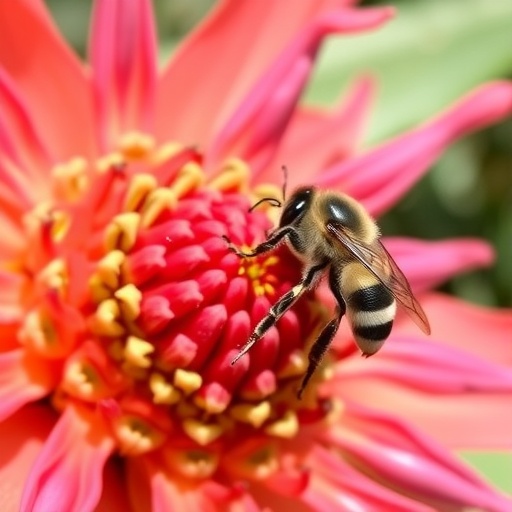In an era where environmental sustainability and biodiversity conservation are paramount, researchers are increasingly turning their focus to the intricate dynamics of plant-pollinator interactions. A recent study led by de Lima-Nascimento et al. sheds light on the interventions that can mitigate floral damage by bees and beetles, particularly focusing on the iconic species Cereus jamacaru DC. (Cactaceae), which flourishes in Brazil’s Caatinga dry forest. This investigation provides compelling insights into the delicate balance between ecosystem management and the persistent threats posed by herbivory.
The Caatinga dry forest, a biome unique to Brazil, is characterized by its rich biological diversity, featuring many endemic species. Among these, Cereus jamacaru is noteworthy not only for its ecological role but also its economic significance as a resource for both local communities and wildlife. However, increased pressures from insect herbivores, notably bees and beetles, have posed significant challenges to the health and vitality of this species. Understanding the factors that drive herbivory in this context is essential for developing effective management strategies.
In their research, the authors employed a comprehensive approach, combining field observations with experimental manipulations to assess the degree of floral damage. By systematically analyzing insect activity and floral responses under varying management scenarios, the researchers were able to quantify the impact of herbivory on reproductive success. This meticulous methodology underscores the importance of empirical data in formulating practical recommendations for conservation efforts.
A critical finding from the study is the role of management practices in reducing floral damage. By implementing specific interventions, such as habitat restoration and the introduction of protective measures, the researchers established a causal link between management strategies and reduced herbivory rates. These observations are crucial for informing policymakers and conservation organizations about the effectiveness of proactive management in preserving plant species and their associated ecosystems.
Furthermore, the study highlights the intricate interactions between different pollinators and herbivores within the Caatinga. Bees, often celebrated as vital pollinators, can also contribute to floral damage when their populations become excessively dense. On the other hand, beetles, while also important for ecological functions, can wreak havoc on flowering plants if left unchecked. The research calls for a nuanced understanding of these relationships, emphasizing the need for a balanced approach that takes into account the roles of various species in the ecosystem.
In an effort to promote sustainable management practices, the study’s authors advocate for collaborative efforts between scientific communities, local farmers, and conservationists. By sharing knowledge about the dynamics of plant-pollinator interactions and effective management strategies, stakeholders can work together to foster environments that support both biodiversity and agricultural productivity. This collaborative framework not only benefits the local economy but also enhances the resilience of the ecosystems within the Caatinga.
The implications of this research extend beyond the boundaries of the Caatinga. As global challenges such as climate change and habitat loss intensify, understanding the factors that influence plant health becomes increasingly critical. The results of this study may serve as a model for similar ecosystems facing herbivory pressures worldwide, promoting a comprehensive understanding of how management practices can be optimized for conservation outcomes.
Additionally, the findings invite a re-examination of the common narrative surrounding pollinators and their roles in ecosystems. While bees are traditionally viewed through the lens of their beneficial contributions, it is essential to recognize their potential for negative impacts under certain conditions. This evolving perspective encourages scientists to develop more holistic models of ecosystem interactions, fostering a deeper understanding of the complexities at play in natural environments.
As the scientific community grapples with the challenges of dwindling biodiversity, this study also emphasizes the importance of long-term monitoring and adaptive management strategies. By continuously evaluating the impacts of different management practices on floral damage over time, researchers can refine their approaches and ensure the sustainability of vital plant species.
Moreover, educational initiatives aimed at raising awareness about the ecological significance of the Caatinga and its endemic species are imperative. By fostering a greater appreciation for the intricate relationships between plants, pollinators, and herbivores, communities can galvanize support for conservation efforts and sustainable practices that benefit both nature and humanity.
In conclusion, the work of de Lima-Nascimento et al. serves as a clarion call for increased attention to the nuanced dynamics of plant-pollinator interactions in the face of environmental pressures. By emphasizing the importance of management practices in reducing floral damage, the research not only contributes to our understanding of ecosystem dynamics but also offers practical pathways forward for conservation in the Caatinga dry forest and beyond. The future of biodiversity hinges on our ability to navigate these complex relationships with care and foresight.
Subject of Research: Management and implications of floral damage by bees and beetles on Cereus jamacaru in the Caatinga dry forest.
Article Title: Management reduces floral damage by bees and beetles in Cereus jamacaru DC. (Cactaceae) in the Caatinga dry forest.
Article References:
de Lima-Nascimento, A.M., Silva, J.L.S., Albuquerque, U.P. et al. Management reduces floral damage by bees and beetles in Cereus jamacaru DC. (Cactaceae) in the Caatinga dry forest. Discov. Plants 2, 275 (2025). https://doi.org/10.1007/s44372-025-00359-1
Image Credits: AI Generated
DOI: 10.1007/s44372-025-00359-1
Keywords: floral damage, bees, beetles, Cereus jamacaru, management practices, Caatinga dry forest, biodiversity, plant-pollinator interactions, conservation strategies, ecological dynamics.




